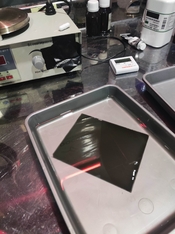Christopher Gio
Member
Hi im new here, i frequently lurk but just recently made an account here.
Im currently trying to make my own Dry Plates, and its honestly a frustrating process. I have made 3 batches and all of them failed. The first two was based on Mark Ostermans formula. It had little to no density & even exposing for 8 minutes only gave a very transparent image.
The last batch was made using Kevin Kliens basic emulsion from TFL. It was completely black. I dont think it was exposed during processing because im pretty careful about that & i do use my darkroom for printing & it has never fogged a paper. I dont really know what im doing wrong. Maybe its the emulsification process of the gelatine? Is the magnetic stirrer mixing to hard? Am i adding the silver too fast/too slow (the first two batches was 3 minutes & the last batch i tried 4 minutes)
So do any of you have any tips for making dry plates? Any help would be welcomed
Im currently trying to make my own Dry Plates, and its honestly a frustrating process. I have made 3 batches and all of them failed. The first two was based on Mark Ostermans formula. It had little to no density & even exposing for 8 minutes only gave a very transparent image.
The last batch was made using Kevin Kliens basic emulsion from TFL. It was completely black. I dont think it was exposed during processing because im pretty careful about that & i do use my darkroom for printing & it has never fogged a paper. I dont really know what im doing wrong. Maybe its the emulsification process of the gelatine? Is the magnetic stirrer mixing to hard? Am i adding the silver too fast/too slow (the first two batches was 3 minutes & the last batch i tried 4 minutes)
So do any of you have any tips for making dry plates? Any help would be welcomed













